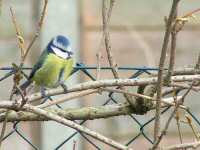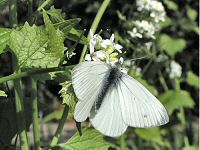| Features: Wildlife Trust Articles |  |
Planting for garden biodiversity
When Spring arrives, our attention is turns to planting our gardens for the coming year. But how should the wildlife gardener decide what to plant?
Biodiverse gardens Blue tit on native elder. Blue tit on native elder. biodiversity is a measure of the number and variety of types of plants and animals in a given space biodiversity is a measure of the number and variety of types of plants and animals in a given space Firstly we need to establish what we want to achieve and, generally speaking, I believe the wildlife gardener wants to maximise biodiversity. There isn't an agreed definition of biodiversity, so I'm going to propose one to help us: biodiversity is a measure of the number and variety of types of plants and animals in a given space.
Firstly we need to establish what we want to achieve and, generally speaking, I believe the wildlife gardener wants to maximise biodiversity. There isn't an agreed definition of biodiversity, so I'm going to propose one to help us: biodiversity is a measure of the number and variety of types of plants and animals in a given space.
 Gardens are amongst the most biodiverse 'habitats' on earth Gardens are amongst the most biodiverse 'habitats' on earth Gardens are amongst the most biodiverse 'habitats' on earth, rivalling tropical rainforest. Unlike rainforests though, gardens aren't naturally biodiverse - gardeners maintain them that way because that's the way we like 'em! Left to their own devices, gardens would be taken over by the native plants adapted to the local conditions. Some naturalistic gardeners are in favour of that, but in fact biodiversity normally drops as a result and Gardens are amongst the most biodiverse 'habitats' on earth, rivalling tropical rainforest. Unlike rainforests though, gardens aren't naturally biodiverse - gardeners maintain them that way because that's the way we like 'em! Left to their own devices, gardens would be taken over by the native plants adapted to the local conditions. Some naturalistic gardeners are in favour of that, but in fact biodiversity normally drops as a result and  most of us want more from our gardens than a small patch of 'wilderness' most of us want more from our gardens than a small patch of 'wilderness' most of us want more from our gardens than a small patch of 'wilderness'. For me the interesting questions are concerned with what we plant to maximise biodiversity, so let's consider a few of them. most of us want more from our gardens than a small patch of 'wilderness'. For me the interesting questions are concerned with what we plant to maximise biodiversity, so let's consider a few of them.
Questions and answersQ.If I cram as many different types of plants into my garden as possible, won't that result in high biodiversity? A. Having more kinds of plants helps, but did you know  there are over three times as many kinds
of insects as plants on the planet there are over three times as many kinds
of insects as plants on the planet there are over three times as many kinds
of insects as plants on the planet? there are over three times as many kinds
of insects as plants on the planet?
 Green-viened white butterfly on native garlic mustard.
Although there are more types of animals than plants, all animals depend on plants in one way or another, so for maximum garden biodiversity, you need to use the right kinds of plants to attract as many kinds of animals as possible. Green-viened white butterfly on native garlic mustard.
Although there are more types of animals than plants, all animals depend on plants in one way or another, so for maximum garden biodiversity, you need to use the right kinds of plants to attract as many kinds of animals as possible.
Q.Should I stick only to native plants? A. My short answer to this is no, but it's not quite so simple.  Some native plants, notably shrubs and trees, will support a huge variety of native animals Some native plants, notably shrubs and trees, will support a huge variety of native animals Some native plants, notably shrubs and trees, will support a huge variety of native animals because they have co-evolved with them over millennia. On the other hand Some native plants, notably shrubs and trees, will support a huge variety of native animals because they have co-evolved with them over millennia. On the other hand  some 'exotic' garden plants, notably many flowers, offer a bounty of nectar and pollen some 'exotic' garden plants, notably many flowers, offer a bounty of nectar and pollen some 'exotic' garden plants, notably many flowers, offer a bounty of nectar and pollen unrivalled by most of our natives, and these also attract many insects to the garden. (And where there are more insects, you can be sure that birds and other animals will follow.) some 'exotic' garden plants, notably many flowers, offer a bounty of nectar and pollen unrivalled by most of our natives, and these also attract many insects to the garden. (And where there are more insects, you can be sure that birds and other animals will follow.)
Deciding what plants to use
There are no hard and fast rules dictating what plants you must use in a wildlife garden any more than there are for gardens of any other idiom. What's right for your situation depends intimately on the nature of your garden, your part of the country and your own likes and preferences. However there are some rules of thumb that are worth bearing in mind when choosing plants for a wildlife garden.
- When considering trees or shrubs for structure and cover, then remember that native species usually benefit wildlife more than exotic ones.
- If you are inclined towards decorative plants, consider using varieties of trees and shrubs derived from our native types.
- For maximum wildlife benefit, use trees or shrubs that occur naturally in the lanes, hedges and woods in your area.
 Female blackbird in non-native pyracantha bush - a boon to any wildlife garden for its thorny cover and winter berries. Female blackbird in non-native pyracantha bush - a boon to any wildlife garden for its thorny cover and winter berries.- Remember that some exotic shrubs are valuable to garden wildlife - often because they supply abundant food (like buddleja for butterflies or the berries of pyracantha for wintering birds) or dense, thorny shelter.
- If you know that a flower is attractive to our native insects and animals, don't be too concerned about whether or not it's native.
- Avoid varieties with unnaturally complex structures, such as double flowers, which often make pollen and or nectar inaccessible to insects.
- Avoid sterile varieties of flowers which may offer limited feeding opportunities to insects.
- If you want a 'naturalistic' feel in your garden, avoid flowers which are too showy. British natives tend to display a subtle beauty with many points of colour amongst ample foliage. Big blousy blooms often look just plain wrong.
- Traditional cottage garden plants and styles tend to favour wildlife.
| First published May 2004. | |
Copyright Richard Burkmar. Permission is hereby granted for anyone to use this article for non-commercial purposes which are of benefit to the natural environment as long the original author is credited. School pupils, students, teachers and educators are invited to use the article freely. Use for commercial purposes is prohibited unless permission is obtained from the copyright holder. |
Back to home page
Do you live in Merseyside? Interested in its wildlife? | |